#contarini madonna
Text
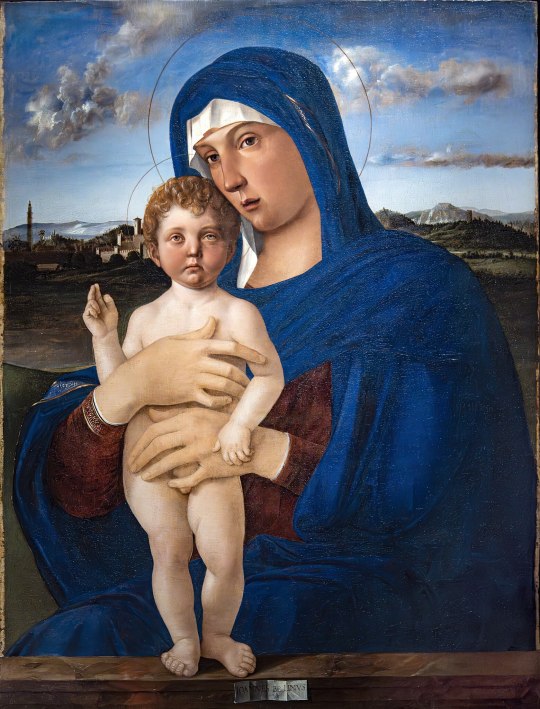
Giovanni Bellini - Madonna and Child. 1475
65 notes
·
View notes
Text
Characters from my untitled original
(to be updated, revised and more)
[Historical fiction novel set sometime in the Middle-ages/Renaissance. In order to have more creative freedom, I've decided to create fictional kingdoms but, since I have thought of no names yet, I'll use the names of the places they're inspired by when describing the characters. For now, at least. It will be updated when I've come up with decent names]
Families => Main characters

Rúadhán & Cecilia. They live on Celtic-like island (think of a remote Greek Island but settled by Celts) with their four children Órla, Mairéad, Clarice and Giuliano. Cecilia was an "Italian" noblewoman of the House of Contarini—that's probably a placeholder name, but I really like it and the Contarini family were an actual Venetian noble family—who gave up everything she had (or was disowned, I still have to decide on that) to marry Rúadhán (he is a merchant and traveled a lot, that's how they met).
Fancasts:
Rúadhán=> Engin Öztürk
Cecilia=> Selma Ergeç
Órla=> Şeyma Burcu Gül
Mairéad=> Isolda Dychauk
Elena=> Synnøve Karlsen
Giuliano=> Ruairi O'Connor
Royal Family (the country is supposed to be akin to Tudor England)

I don't have a name for the king and queen (might as well end up being emperor/empress) yet, I only know he married three times and two of his wives executed.
Children from his first marriage (from left to right): Princess Elizabeth, Princess Alexandra, Princess Mary
Fancasts:
King=> Anthony Head
Queen=> Hülya Avşar
Princess Elizabeth=> Gaia Weiss
Princess Alexandra=> Gözde Türker
Princess Mary=> Holliday Grainger

King's second wife and son, Prince Arthur.
Queen #2=> Vildan Atasever
Prince Arthur=> Max Irons

Third marriage to Queen Jane and son Henry.
Queen Jane=> Annabelle Wallis
Prince (later King) Henry=> Oliver Zetterström
-
Lady Catherine, the King's illegitimate daughter, her mother is unknown.
Fancast=> Astrid Berges-Frisbey


House of Venier (family crest=> eagle)

I don't know about titles. Italian nobility (they're Italian) used 'Messer' and 'Madonna' so I guess I might keep them. They're nobles, so why not.
Messer Piero and Madonna Maddalena and their children Leonardo/Lorenzo(?), Laura and Lucrezia. Lorenzo (placeholder name for now, but I think it will stick) serves as Ambassador and ends up marrying Elena/Helena
Fancasts:
Piero=> Dustin Hoffman
Maddalena=> Tülin Özen
Leonardo/Lorenzo=> Daniel Sharman
Laura=> Gonca Sariyildiz
Lucrezia=> Merve Boluğur

Matilda Lutz as Lisa (I still have to pick a name)=> Leonardo/Lorenzo's twin sister.
Both countries (both the "Italian" and the "English" one might have "Ottoman" influences as a result of an alliance)
Main couples:

Also, these two up above are basically a more historical version of Elenwë from my LOTR/Silmarillion fic "The Lady of Ithilien"
These are the main characters, this post will be updated periodically as I come up with new ones!
11 notes
·
View notes
Text
Verona, Venice, Lake Garda Itinerary
Verona
Day 1:
Juliet’s Tomb - €7 (pays for Juliet’s house)
Juliet’s Statute - FREE
Juliet’s House - paid for
Castelvecchio Museum - €7 pays for Lapidary Museum
Lapidary Museum Maffeiano - paid for
Ponte Pietra - FREE
Teatro Romano - €4
Cattedrale di Santa Maria Matricolare - €4
Piazza delle Erbe
Piazza dei Signori + Statue of Dante FREE
Scaliger Tombs - FREE
Giusti Garden - €11
Day 2:
Basilica di San Zeno Maggiore
Verona Arena - €9
Piazza Bra - FREE
Porta Brosari - ancient entrance to the city - FREE
Santuario della Madonna di Lourdes - 40 min hike + sanctuary on a hilltop overlooking Verona
Day 3 VENICE:
9:22 train arrives 10:50 - £20
St. Mark’s Square - FREE
St. Mark’s Basilica - €20 + Pala D’Oro + Museum Loggia Cavalli
St Mark’s Clock Tower
Doge’s Palace
Bridge of Sighs - FREE
Grand Canal - FREE
Rialto Bridge - FREE
Basilica di Santa Maria della Salute
Librairie Aqua Alta - FREE
Venetian Arsenal (12th-century shipyard) - FREE
Palazzo Contarini del Bovolo
Museo Correr
Ponte Chiodo - FREE
Squero di San Trovasco - FREE
Gondola Ride - £80
La Tecia Vegana for food
Return train at 9 pm
3 notes
·
View notes
Text

WIP CH.2- "Confluence"
(...)"Madonna Lucia, my eyes rejoice in seeing you," she heard Tiziano say, beaming at the sight of her. With quick strides, he was soon in front of her, his large hands taking her own with gentle grace.
He bowed, bringing her hands to his lips, never breaking eye contact with her.
Lucia had to contain her surprise: his dark eyes, she noticed now that he was up close, were almost the same shade as Federico's, but they held none of their lively light nor the soft warmth.
"Welcome to Palazzo Ducale, Messer Contarini. You are always the most welcomed guest in this house,"
"And you are, as ever, the most gracious host," he whispered, giving her hands another peck and a smile under his trimmed beard. "I have looked forward to meeting you all day, Mia Signora. I was supposed to come tomorrow, but I found myself impatient and couldn't wait any longer, the rain be damned."
Lucia smiled and nodded politely, as she had been taught to, without uttering a single whisper.
Tiziano looked at her for a while longer, studying her face, until his eyebrows knitted in a worried look.
"Forgive me for my bluntness, but you look pale, Madonna Lucia. Your Lady Mother was telling me that you had not felt the best, these past weeks?" He whispered with gentleness. She saw him raise his hand to reach her cheek, and she froze on the spot when his knuckles touched her skin. Lucia felt her heart clenching in her chest, wanting with all of her might that the hand caressing her was Federico’s.
"No-nothing to worry about, Messer Contarini. Just the dampness of the lagoon after all this rain,"she merely said, shifting ever so subtly to get away from his touch.
"When it comes to your wellbeing, I worry, Madonna Lucia. You are so dear to my heart," he murmured, his smile growing soft. He then turned toward her mother, his voice low and grave. "If you allow, Dogessa Isabella, I will have my personal physician come and take a look at Madonna Lucia. We cannot run the risk of her falling sick."
"You are most kind, Messere, a true blessing to this family, first with the Election of my Lord Husband to Doge of the Serenissima and now with our dear Lucia,”
“This is the least I could do, Dogessa. It is my duty as a Contarini and as a man to regard for the wellbeing of one of the Figlie della Laguna,”
Lucia saw her mother’s face lit up with a radiant smile and her cheeks turning red with joy: why was she so ecstatic for something so little?
When she focused her attention on Tiziano again, she saw that he was staring at her, his face tilted and his lips thinned in an enigmatic smile that Lucia didn’t know how to decipher.
“Madonna Isabella, will you be so kind as to give me your permission to take a walk with your daughter in her garden?” Tiziano asked, his dark irises never leaving Lucia's face.
The young woman's eyes grew wide, as she felt a chill of dread running down her spine.
She didn't want to be alone with him in her garden.
She didn’t want him in her garden.
She didn’t want his presence to desecrate the place where she and Federico had shared their kisses, where Federico had held her so close to him she had felt his heartbeat against her cheek...where she had experienced the warmth of love for the first time.
That Garden was theirs and theirs alone.
----------
So here it's a small snippet of Ch.2 of Rondó Veneziano. I worked proficiently today, and I think I might have finally broken that freaking block that was dragging me down (but I am going to touch wood anyway because you never know.)
It's going to be a little angsty, but I promise that the last chapter will be so fluffy and sweet, y'all will visit the dentist afterwards.
TRUST.
Many thanks to Dearest @giuliettaluce for her kindest words, because they actually gave me the push to work on this today. (You are an angel, my dear. Thank you so much for always supporting me!💗)
Well, I am off to work on this chapter a little more!
Hope you'll like this!💗
--NEMO
#assassin's creed#federico Auditore#Assassin's creed II#Lucia Barbarigo#my writing#my oc#Nemo Writes
12 notes
·
View notes
Photo
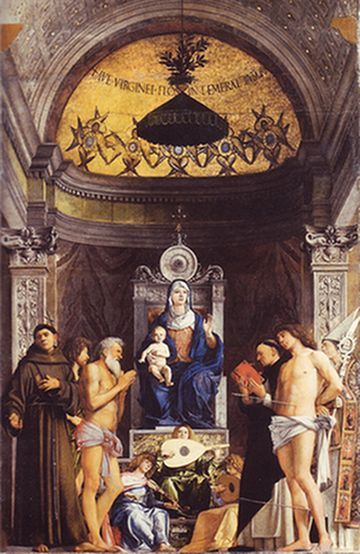
Pala di San Giobbe, Giovanni Bellini, 1487 circa, olio su tavola. L'opera è una Sacra conversazione: attorno all'alto trono marmoreo di Maria col Bambino, ai cui piedi si trovano tre angeli musicanti, sono disposti simmetricamente sei santi, tre per parte: a sinistra san Francesco, Giovanni Battista e Giobbe, a destra i santi Domenico, Sebastiano e Ludovico di Tolosa. I santi vennero ripresi e imitati per decenni: san Francesco ad esempio ricompare quasi identico nella Pala di Castelfranco di Giorgione. La parte più straordinaria è rappresentata dalla volta a cassettoni che introduce prospetticamente alla composizione sacra, con pilastri ai lati, che sono uguali a quelli reali dell'altare originale. La nicchia profonda e ombrosa dello sfondo dilata lo spazio attorno al gruppo sacro, all'ombra di una calotta coperta da mosaici dorati nel più tipico stile veneziano. Si tratta quindi di un prolungamento virtuale dello spazio reale della navata, con figure al contempo monumentali e caldamente umane, grazie al ricco impasto cromatico. La luce si riverbera sui dettagli, venendo catturata dai mosaici o dagli strumenti musicali degli angeli. Maria è raffigurata isolata e assorta nella sua maestà, con un Bambino molto simile nella fisionomia del viso a quello della Madonna Contarini, sempre all'Accademia, e il retaggio bizantino è ancora percepibile nell'iconico distacco della divinità, che la rende misteriosa e irraggiungibile. La Pala è esposta nelle Gallerie dell'Accademia (Venezia).
4 notes
·
View notes
Photo
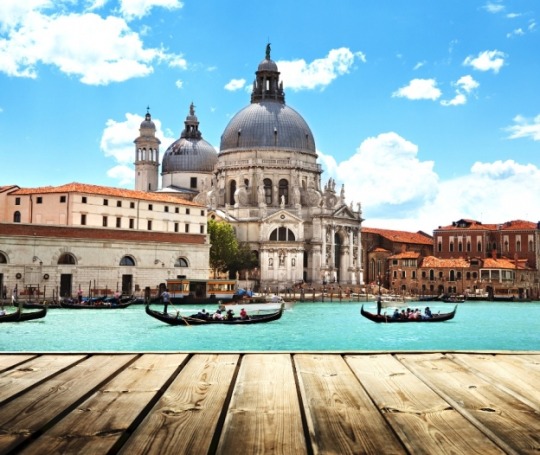
If you are going to be in Venice on 21st November, you will have a chance to see and participate in one of the city’s most loved and least “touristy” festivals: the Festa della Madonna della Salute (the Festival of the Madonna of Health).
The festa’s origins go back to the plague of 1629 – 31 when many cities of Northern Italy were affected. This plague often referred to as the “Great Plague of Milan”, is described by Alessandro Manzoni in “I Promessi Sposi” (“The Betrothed”).
Mantua was particularly badly affected after French and German troops carried the plague there and Duke Carlo Gonzaga sent messengers to Venice to seek help. The Venetians isolated the ambassadors on the island of San Servolo, but the plague had already reached the city via a carpenter who had been sent ahead to prepare lodgings for the ambassadors.
Within weeks, Venice was decimated by the plague and even the Doge and members of his family died. 46,000 people out of a population of 140,000 perished. No medicine was effective and eventually, the new Doge, Nicolò Contarini, decided, with the Senate, to ask the Madonna for help. They organised a procession and people walked around the Piazza San Marco with lit torches for three days and nights. The Doge and the Senate made a solemn promise to the Madonna that, if she delivered them from the plague, they would build a beautiful temple to her.
The very next week there were fewer cases of plague and finally, in 1631, the city was declared free of the disease. Honouring their promise to the Madonna, the Senate commissioned a young architect called Baldassare Longhena to build the temple, which he designed in the form of a crown for the Madonna. The church was built in the Palladian style and was completed in 1681, the year before Longhena’s death. It was admired by visitors from all over the world as an example of Baroque style and today, it is one of the first buildings that come to mind when we think of Venice.
The church was consecrated on 21st November 1687 and a bridge of boats was constructed so that people could reach it from the city centre.
source: Italy Magazine.
15 notes
·
View notes
Text
What to see and do in Bergamo, Italy

Bergamo is one of those Italian cities that makes everyone who visits it fall in love. Located in a privileged area of the Italian Alps in the Lombardy region, the beautiful city of Bergamo has a bit of everything. Majestic lakes to admire in the surroundings, an immediate mountain to the city that dresses in light colors in winter welcoming thousands of visitors who enjoy snow sports and green and brown colors printed in their nature, and that is their modest climates in any season make traveling to Bergamo a great idea throughout the year.
What to see and what to do in a day in Bergamo, Italy.
Divided by the Venetian walls of medieval origin, Bergamo consists of the "Città Alta" precisely in the outer and elevated part and the "Città Bassa" that composes the historic heart of the city living with the modern residential growth of the area.
In the past, it has been conquered by Celts, Romans, Venetians, Napoleons and even Austrians, which gives it the privilege of having different types of architecture and art living in perfect harmony.
Piazza Vecchia

Piazza Vecchia in Bergamo, Italy
Known as one of the busiest points of the Upper City, is the "Old Square", which honors its name because it is surrounded by history made architecture; The Contarini Fountain, the Civic Tower, the Raggione and Nuovo Palaces are located near the square and offer an attraction of majestic beauty typical of Italian cities.
It is the perfect place to enjoy a good meal or coffee while its different buildings of stone and brick move it to other times and although the costs are somewhat high you should not miss the opportunity to meet the whim of visiting it and get lost among its picturesque streets full of tourists, troubadours, bars, libraries, restaurants and old facades.
Piazza del Duomo
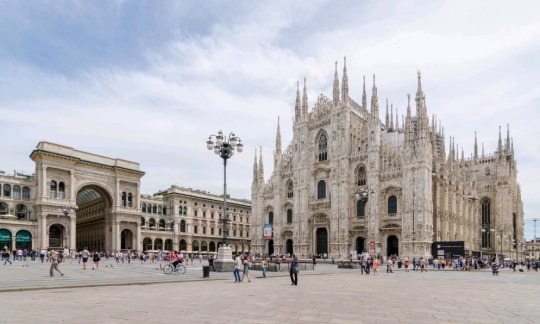
Piazza del Duomo in Bergamo, Italy
Another popular place is Piazza del Duomo, it is located behind Piazza Vecchia but it is still part of the heart of the Città Alta. Here we find the Duomo (or Cathedral) of Bergamo, the Episcope and the Church of Santa María Maggiore. The latter is one of the most important monuments in the city. It was built in the year 1137 to thank the Madonna for its protection in the plague epidemic that hit Europe in the twelfth century.
An excellent visit for those interested in religious buildings, Romanesque and Venetian styles with materials such as marble, stones, quarries outside and fine wood and interior details. Access is free and free to know these buildings and you can even have a view from the top going up the Civic Tower that gives a 360 panoramic view of the entire square.
Chapel Colleoni

Chapel Colleoni, a most beautiful building in the city
Polychrome marbles, biblical reliefs, Roman bas-reliefs, and an octagonal dome characterize this chapel that was dedicated to Bartolomeo Colleoni while being a proper mausoleum for this saint, it is considered one of the most beautiful buildings in the city.
The interior is as majestic as its exterior, here we find the main altar, reliefs that detail the life of Christ, statues, and lions of stone as well as the Colleoni tomb in a sarcophagus of artistic detail.
It is a must to visit, it is worth knowing a little more about the history of this warlord to see the construction with better detail and meaning. It can be visited at any time of the year but in bridges and holidays, the number of tourists increases considerably.
Gombito Tower
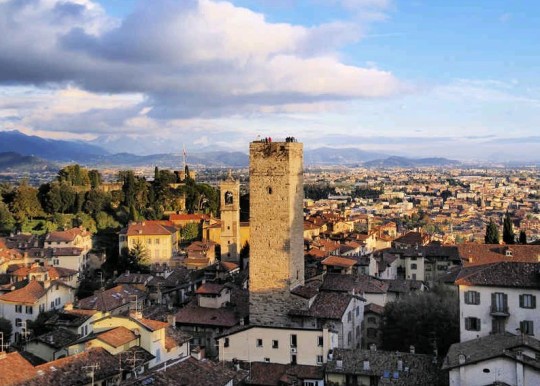
Gombito Tower, the tallest structure in Bergamo
This tower gains its name because it is located at the intersection of two important streets (Gombito comes from the Latin word "compitum", which can be interpreted as "crossing" or "division").
In the past it served as a military tower, from here places such as Piazza Vecchia were monitored in the city center, later it went to the civil plane, it is built in stone and has a height of 52 meters, thus being the tallest structure in Bergamo.
The tower opens its doors in the spring and summer seasons but all year you can take advantage of it to see it outside while walking through the «Via de Gombito» with a picturesque style full of many souvenir stalls, patisseries, and cafes, you can get to the tower walking or by the funicular.
Basilica Santa María la Mayor

Basilica Santa María la Mayor, must-stop for all travelers
This building located in Piazza del Duomo is not far behind in beauty and complexity as the other attractions around it. The facade has Lombard-Roman styles, its marbles are carved in whimsical forms and its walls and columns are upholstered in Flemish and Florentine drawings.
It has a ceiling with good interior detail, the octagonal dome, biblical chapters on the walls worthy of the master painter Lorenzo Lotto as well as the altar or choir with impressive work in the background of marquetry (pieces of wood that together form an image).
It is a must-stop for all travelers and you need to completely surround it to appreciate the different views from the outside, the visiting hours are somewhat strict and it is advisable to visit it in the hours of less influx and with time so that there are not so many people and enjoy the Better visit.
Rocca Calascio

Rocca Calascio the best point to appreciate the entire city
At the top of the mount of Santa Eufemia, this military-type building is erected that served as the headquarters of the Italian troops and also a local jail, within "La Rocca" we find the church of Santa Eufemia, the Historical Museum of Bergamo and the Parque de la Remembrance
The park offers gardens, ups and downs, towers, balconies and even remnants of the two world wars such as canyons and armed cars. Its peculiar circular tower is the best point to appreciate the entire city and even the dawn of Milan.
Ideal to visit with family and children on a sunny day to enjoy lying on their lawn under the shadows offered by the woodland or walk alongside its walled system which also tells the place as "The fortress."
The Medieval Citadel

Piazza Cittadella, the most interesting places of medieval times, located in Bergamo
Piazza Cittadella is one of the most interesting places of medieval times and is located in the mere center of Bergamo giving it a privileged position.
It comprises two imposing military palaces that now house both the Natural Science Museum and the Archaeological Museum that offer rooms with items from prehistory to medieval times as well as geological and paleontological remains from different parts of the world and even a very well preserved mammoth, both museums are open to the public all year round but their schedules change in winter and spring.
Around these museums, you can also see ancient stone towers, vaults, and pillars, cobbled and cobbled streets and a corridor with arches where they put stalls selling souvenir items.
San Vigilio Castle

San Vigilio Castle military construction of Bergamo
This military construction of Bergamo has towers, canyons and embrasures are located on the top of a hill 500 meters high that bears his name and also inside houses a network of passageways and underground galleries.
To get here you can take the funicular for approximately 2 euros or make the journey through the stairs that demand some condition but that offer the advantage of saving the ticket, there is little left of the construction of the castle however it is worth visiting because the view it offers towards the pre-alps and the high city makes it worth all the effort, ideal to visit in the afternoon where you can lie on the grass and make a picnic surrounded by silence and landscape.
The lower town of Bergamo "Città Bassa"

The lower town, Città Bassa, in Bergamo
This is the modern part of Bergamo, the avenues are wider and the constructions and houses are not as old compared to the high city, to move here you can do walking or taking the funicular, in fact, many of Bergamo's inhabitants live in this area.
Its main attractions are the Palace of Justice as well as the palace of the Italian banking, the chamber of commerce, the Piazza Dante and the Pinacoteca of the Carrara Academy, the latter very visited presenting more than 1700 paintings by different artists.
It is advisable to visit it in the morning or afternoon and walk indistinctly through its streets, the stay can last in about four or five hours, and on Sundays, there are usually small local markets that offer products of the region and various items, there are also shopping centers such as "Porta Nuova" open any day of the week.
What to see near Bergamo and surroundings
Iseo Lake

Iseo Lake, the fourth largest lake in Italy
This "s" shaped lake and feeding on the Oglio River rests in a valley where the pre-alpine mountains are erected, which gives it an enormous natural beauty despite being close to the industrialized areas.
Also known as Lago Sebino is the fourth largest lake in Italy, and is located in the region of Lombardy, it has about six towns and two small islands in the private domain. It can be reached by car, train or bicycle from Milan or Bergamo which is only an hour away.
This place offers plenty of activities and attractions for all types of visitors who want to spend a good weekend, riding a motorboat, kayaking or sailing through its waters is the main thing, hiking and mountain biking are also the most chosen among the tourists to spend energy.
But if you prefer a place to rest, relax and get to know it little by little, then stay in the right place; Iseo, Monte Isola, Pisogne and Sarnico have different things to visit, such as old hulls and medieval buildings, small castles, beautiful historical centers, museums and even a green oasis in the middle of this aquifer.
The dining options are varied and good, near there are vineyards, goat cheeses and without forgetting, of course, its fresh fish such as Palmerino or Farra in any of its inns or restaurants at the foot of the riverbank.
San Pellegrino Terme
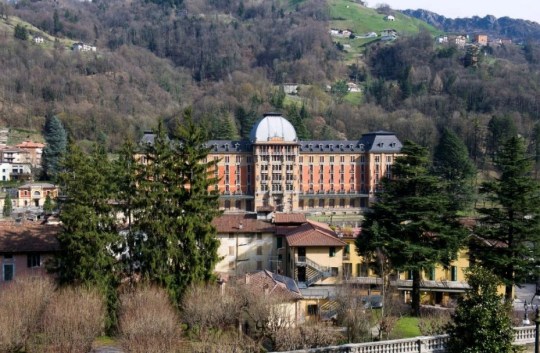
San Pellegrino Terme called Al Pellegrino in Bergamo
At half an hour from the city of Bergamo is this town called Al Pellegrino specialized in rest at its highest level, as it has an attraction that few could resist: A center with hot springs, elegant and spa areas.
The "belle epoque" is the way we live here, since the beginning of the 90s, the spirit of the place is to offer eternal rest of the highest quality. Casino, party halls, hot springs or pools, and hotels decorated with first-class materials such as marble, artistic glass, and mosaics in perfect communion with all the avant-garde infrastructure.
The visit to this place can be a bit expensive if you want to enjoy it to the fullest, it is the best destination to spend a weekend or even whole weeks that will be worth every euro invested. Even the site has just undergone a remodeling of more than 200 million euros that embellish it more in its designs and thus offering better quality services.
The quality and cleanliness of its waters are not only used for reasons of relaxation and recreation but also for medicinal purposes fighting stomach diseases and of course, its use to bottle for sale to the whole world, this is where the so famous drinks of slightly gasified water brand S. Pellegrino.
Crespi d'Adda

Crespi d'Adda, World Heritage Sites by UNESCO
The site added to the list of World Heritage Sites by UNESCO as "an exceptional example of the phenomenon of working people, the most complete and best-preserved in southern Europe."
This small town has its origins in the cotton industry, and it is that a man named Crespi was the one who created a complete place not only to work but to settle and live there. Factories, houses, schools, a castle, churches, hospitals, and even a pantheon would be part of the system that even preceded what the government itself could offer.
The employer, as well as the workers and their families, were then established in this town that was governed mainly by the demands of the company but at the same time had already established a way of life typical of any other community.
What impresses here is its magnificent state of conservation as well as buildings that any other people would envy. Medieval and English- style architectures can be found here, even in this place, it was where the electrical service to the public was installed rather than anywhere else in Italy.
The factory operations ended in 2004 however the town is still inhabited and with open arms for all public to visit. To get there it is necessary to take the land route from Bergamo at just thirty minutes or the train with a duration of one hour, you can also make the trip from Milan on the same means of transport with a little more time to arrive.
Como Lake

Como Lake of glacial origin is one of the deepest in Europe
This lake of glacial origin is one of the deepest in Europe (over 400 meters) and the third-largest in Italy after the Garda and Maggiore. Its beauty is due to the privileged position in the middle of alpine mountains that give it that characteristic of many Italian lakes, combined with a temperate climate typical of the Mediterranean that gives the opportunity to be visited practically at any time of the year.
Among its attractions we find villages on its shore with pleasant peculiarities, Nesso, for example, is a hamlet located almost capriciously in a tense terrain and also a stream flows in the middle of it, making a small waterfall that flows into the lake and a small stone bridge to observe it better.
Varena another set of houses that seems from afar as a miniature town because the magnitude of its rocks behind makes it look like a point in the middle of nowhere. Its picturesque little streets combined with colorful and well-maintained facades make this place a charm. There are more villages at the foot of the lake such as Bellagio with a stately style or Menaggio located in the center of the lake and the main crossing of boat travelers.
The city of Como, which is the capital of the region, offers points of interest such as a castle, museums, cathedral, towers, and bridges in medieval style; It is a mandatory stop if you have more days available when visiting the lake.
What to eat in Bergamo; typical dishes
The gastronomy of Bergamo, as in all of Italy, is very select and throughout the city, we can find restaurants and places to eat really well because the products of the region are fresh, well cared for and at a reasonable price.

Casoncelli di Bergamo, ravioli with a meat and cheese
His best-known dish is the Casoncelli di Bergamo that is ravioli with a meat and cheese filling, accompanied by fruits such as grapes and pears, this is the food that has brought his cuisine to international fame.
The most widely used culinary ingredient in the region is the already known polenta, which is yellow cornmeal and is used in many other dishes such as in the "polenta e uccelli", which are small roasted birds pierced with a shaped stick of skewer accompanied with this prepared flour.
Among the most precious are sausages and meats such as sausages, sausages, bacon, and other cured meats; Black truffles of different types that occur in the region at different times of the year as well as its large variety of cheeses made mostly by hand such as Branzi, Agri, Tallegio, Caprini among many more.
Their desserts are Donizetti and Donizzeti cake and Pan di Spagna, the area is also a honey and wine producer, offering red, white and muscat wines.
Photos via, Shutterstock, Gettyimages, Wikimedia.
Read the full article
0 notes
Photo

Venezia è una delle città più amate del nostro Paese, un luogo unico al mondo ricco di storia e di fascino, un posto in grado di offrire un’atmosfera sempre suggestiva in ogni stagione dell’anno. Nonostante serva molto tempo per conoscere la laguna veneziana, è possibile vedere Venezia in un giorno a piedi scoprendo i luoghi principali della città. Oggi proponiamo uno degli itinerari per visitare Venezia a piedi, per ammirare i palazzi storici e i monumenti da Piazzale Roma fino alla meravigliosa Piazza San Marco. Un giorno a Venezia: la partenza da Piazzale Roma Questo tour di Venezia parte da Piazzale Roma, il capolinea al quale giunge chi arriva nella laguna in macchina o in autobus, mentre chi utilizza il treno scende alla stazione di Santa Lucia, situata a pochissima distanza dall’altro lato del Canal Grande. Da entrambi i punti è possibile prendere il vaporetto, un vero e proprio simbolo di Venezia al pari del giro in gondola, optando per le linee 1 e 2 che risalgono il principale canale veneziano fino a raggiungere Punta della Dogana da Mar, in prossimità di Piazza San Marco. Il tragitto intero dura all’incirca 40 minuti, tuttavia acquistando il biglietto giornaliero è possibile scendere presso qualsiasi fermata del vaporetto, usufruendo del mezzo per vedere Venezia in un giorno, scoprendo le bellezze presenti lungo le due sponde del Canal Grande. In alternativa è possibile partire da Piazzale Roma e proseguire a piedi, l’itinerario è pressoché identico, ma in barca si possono raggiungere facilmente entrambe le rive in maniera più agevole. Visitare Venezia in un giorno: il Ponte della Costituzione Il primo luogo d’interesse, durante il percorso a piedi di Venezia, è rappresentato dal Ponte della Costituzione, la discussa opera architettonica realizzata dal famoso architetto spagnolo Santiago Calatrava, la quale ha subito recentemente un intervento di sostituzione dei pannelli di vetro della pavimentazione. Si tratta di un’opera spettacolare inaugurata nel 2008, considerata un vero capolavoro d’architettura e design, nei cui pressi si trova anche la bellissima Chiesa degli Scalzi, che ospita la salma dell’ultimo doge di Venezia, Lodovico Manin. Itinerario a Venezia: Fontego dei Turchi e Palazzo Vendramin-Calergi La seconda tappa dell’itinerario è lo splendido palazzo ottocentesco di Fontego dei Turchi, del quale dal vaporetto si può ammirare la facciata bizantina risalente al XII secolo. All’interno si trova il Museo di Storia Naturale di Venezia, dove è custodita una grande collezione di oltre 2 milioni di pezzi di Botanica e Zoologia. Sull’altra sponda del Canal Grande è presente Palazzo Vendramin-Calergi, attuale sede del casinò di Venezia, un edificio maestoso realizzato nel ‘400 dall’architetto Mauro Codussi. Percorsi di Venezia a piedi: Ca’ Pesaro Riprendendo il cammino bisogna fare un breve tratto a piedi, oppure a bordo del vaporetto, per incontrare Ca’ Pesaro, un bellissimo palazzo in stile barocco al cui interno si trovano il Museo Internazionale di Arte Moderna e il Museo di Arte Orientale. Aperti alle visite tutti i giorni tranne il lunedì, i due musei propongono mostre ed eventi di importanti artisti italiani e stranieri, con disegni, quadri, fotografie e stampe dei maggiori esponenti dell’arte contemporanea odierna. Cosa vedere a Venezia in 1 giorno: Ca’ Oro L’itinerario per vedere Venezia in un giorno prevede una fermata a Ca’ Oro, un elegante edificio gotico affacciato sul Canal Grande, il quale di notte offre uno spettacolo unico grazie all’elaborata illuminazione della facciata. Chi desidera può visitare all’interno la Galleria Giorgio Franchetti, dove sono esposti alcuni capolavori del Rinascimento italiano, come il quadro di San Sebastiano del Mantegna, la Venere allo specchio di Tiziano e le sculture in bronzo provenienti dalla Chiesa dei Servi, tra cui l’Apollo di Jacopo Bonaccolsi. Visitare Venezia a piedi: mercato cittadino e Ponte di Rialto Finalmente si arriva a uno dei luoghi più famosi da vedere assolutamente a Venezia, il Ponte di Rialto e l’annesso mercato cittadino. Il ponte è un vero e proprio simbolo della laguna veneziana, un’opera architettonica celebre in tutto il mondo, costruita nel 1591 su progetto dell’architetto Antonio da Ponte, che vinse la concorrenza di Palladio e dello stesso Michelangelo. La struttura rappresenta l’anima commerciale e marittima della Venezia antica, quando il ponte di legno lasciò spazio a questa grandiosa opera architettonica, simbolo della grandiosità veneziana dell’epoca. Il Ponte di Rialto, dopo la sua costruzione, rimase a lungo l’unico punto per attraversare il Canal Grande, fino alla realizzazione nella metà del XIX secolo del ponte di ferro, chiamato oggi Ponte dell’Accademia. Nei pressi del Ponte di Rialto è presente il mercato cittadino, un posto ideale dove passeggiare a Venezia a piedi e acquistare un souvenir o un prodotto tipico locale, con i banchi che aprono tutti i giorni dalle 9 alle 12 della mattina, oppure dove fermarsi per un caffè o un pranzo in uno dei tanti ristoranti della zona. Itinerari di Venezia a piedi: Palazzo Balbi e Ca’ Foscari Da vedere a Venezia in un giorno c’è ovviamente Ca’ Foscari, meraviglioso palazzo in stile gotico risalente al XV secolo, oggi a disposizione della prestigiosa Università Ca’ Foscari, ma un tempo edificio frequentato da principi, nobili e imperatori, tra cui il re di Francia Enrico III che qui soggiornò più volte nel XVI secolo. Sulla sponda opposta del Canal Grande è presente invece Palazzo Balbi, un signorile edificio costruito nel 1590, attuale sede del Consiglio Regionale del Veneto, di fianco al quale si erge l’elegante Palazzo Contarini. Cosa fare a Venezia in un giorno: Ca’ Rezzonico e Palazzo Grassi Riprendendo la marcia per continuare il percorso turistico di Venezia a piedi, dopo un tratto di alcuni minuti si arriva in prossimità di Ca’ Rezzonico, uno dei palazzi più famosi e visitati della città, sede del Museo del Settecento Veneziano. Si tratta di un edificio in stile barocco realizzato tra il XVII e il XVIII secolo, al cui interno è possibile scoprire gli arredi dell’epoca d’oro della laguna, ammirando alcuni grandi capolavori del Tiepolo. Dall’altro lato del canale è presente Palazzo Grassi, anch’esso del ‘700, sede del Museo d’Arte Contemporanea di Venezia. Venezia a piedi: dalle Gallerie dell’Accademia alla Collezione Peggy Guggenheim Camminando a Venezia a piedi dalla stazione di Santa Lucia, oppure utilizzando il comodo vaporetto, una tappa d’obbligo è quella alle Gallerie dell’Accademia, l’antica scuola di pittura e scultura dove venivano istruiti i giovani artisti veneziani. Questo museo statale ospita una delle più complete collezioni di pitture veneziane, con meravigliosi capolavori di artisti del calibro di Giorgione, Tintoretto, Bellini e Tiziano, oltre a mostre ed eventi di risonanza internazionale. Di pari importanza è la Collezione Peggy Guggenheim, inserita nella splendida location di Palazzo Venier dei Leoni, con opere straordinarie dell’arte americane ed europea del XX secolo. Tra i pezzi presenti all’interno della collezione ci sono pitture e sculture di Duchamp, Pollock, Kandinsky, De Chirico e Picasso, inoltre è disponibile una prestigiosa raccolta di grandi interpreti del Futurismo italiano, con realizzazioni di Soffici, Morandi, Boccioni e Russolo, estremamente interessanti per capire la storia contemporanea del nostro Paese. Venezia in un giorno: l’arrivo a Piazza San Marco A Venezia gli itinerari portano sempre a Piazza San Marco, icona della laguna veneziana conosciuta e apprezzata in tutto il mondo, infatti anche questo percorso non fa eccezione. Passando davanti la Basilica della Madonna della Salute, dopo aver ammirato l’antico attracco delle imbarcazioni presso la Punta della Dogana da Mar, basta percorrere Calle Vallaresso per raggiungere Palazzo Correre e infine la spettacolare Piazza San Marco, centro turistico della città di Venezia. Naturalmente servirebbero diverse giornate per scoprire i tesori artistici, architettonici e storici custoditi in questo luogo simbolo di Venezia, tuttavia in poche ore è possibile passeggiare all’interno della piazza, scattare alcune fotografie e visitare almeno la bellissima Basilica di San Marco. Questa chiesa iconica è stata costruita nell’XI secolo, nonostante abbia subito negli anni numerosi interventi, con all’interno il museo e le splendide sculture dei Cavalli di San Marco, mentre dall’esterno svetta il Campanile con i suoi 98,6 metri d’altezza. Da vedere, con un po’ di tempo a disposizione, ci sono ovviamente Palazzo Ducale e la Libreria Acqua Alta, la caratteristica Piazzetta dei Leoncini, la Torre dell’Orologio, il Museo Correr e il Ponte dei Sospiri, del quale si gode un’ottima vista dalle prigioni nei sotterranei di Palazzo Ducale. Altri luoghi d’interesse nella zona sono le Colonne di San Marco e San Todaro, dove venivano allestite le esecuzioni durante il XVIII secolo, il Museo Archeologico Nazionale e Caffè Florian, uno dei più antichi della città, frequentato dal 1720 da personaggi come Goldoni, Foscolo e D’Annunzio. Altri itinerari per visitare Venezia Quello proposto è soltanto uno dei percorsi possibili, infatti Venezia è una città tutta da scoprire, che mette a disposizione tantissime attrazioni, musei, palazzi e chiese in tutte le zone della laguna. Ad esempio è possibile optare per l’itinerario lungo i giardini storici della città veneziana, che conta oltre 500 parchi pubblici e privati molti dei quali sconosciuti ai turisti, oppure scegliere un tour tra le isole di Venezia, come Murano, Burano, San Giorgio e Mazzorbo. Altrimenti si possono visitare le bellissime chiese di Venezia, un percorso spirituale per vedere i luoghi di culto della laguna, che ospita complessivamente oltre 148 strutture tra basiliche, conventi e chiese. Un giorno a Venezia è sicuramente un tempo insufficiente per vedere tutto ciò che questa incredibile città ha da offrire, allo stesso tempo è un modo per conoscere alcuni luoghi simbolo della Serenissima, in attesa di tornare nella città più affascinante e suggestiva del nostro Paese. https://ift.tt/2Zc6Bik Tour di Venezia in una giornata: le tappe imperdibili Venezia è una delle città più amate del nostro Paese, un luogo unico al mondo ricco di storia e di fascino, un posto in grado di offrire un’atmosfera sempre suggestiva in ogni stagione dell’anno. Nonostante serva molto tempo per conoscere la laguna veneziana, è possibile vedere Venezia in un giorno a piedi scoprendo i luoghi principali della città. Oggi proponiamo uno degli itinerari per visitare Venezia a piedi, per ammirare i palazzi storici e i monumenti da Piazzale Roma fino alla meravigliosa Piazza San Marco. Un giorno a Venezia: la partenza da Piazzale Roma Questo tour di Venezia parte da Piazzale Roma, il capolinea al quale giunge chi arriva nella laguna in macchina o in autobus, mentre chi utilizza il treno scende alla stazione di Santa Lucia, situata a pochissima distanza dall’altro lato del Canal Grande. Da entrambi i punti è possibile prendere il vaporetto, un vero e proprio simbolo di Venezia al pari del giro in gondola, optando per le linee 1 e 2 che risalgono il principale canale veneziano fino a raggiungere Punta della Dogana da Mar, in prossimità di Piazza San Marco. Il tragitto intero dura all’incirca 40 minuti, tuttavia acquistando il biglietto giornaliero è possibile scendere presso qualsiasi fermata del vaporetto, usufruendo del mezzo per vedere Venezia in un giorno, scoprendo le bellezze presenti lungo le due sponde del Canal Grande. In alternativa è possibile partire da Piazzale Roma e proseguire a piedi, l’itinerario è pressoché identico, ma in barca si possono raggiungere facilmente entrambe le rive in maniera più agevole. Visitare Venezia in un giorno: il Ponte della Costituzione Il primo luogo d’interesse, durante il percorso a piedi di Venezia, è rappresentato dal Ponte della Costituzione, la discussa opera architettonica realizzata dal famoso architetto spagnolo Santiago Calatrava, la quale ha subito recentemente un intervento di sostituzione dei pannelli di vetro della pavimentazione. Si tratta di un’opera spettacolare inaugurata nel 2008, considerata un vero capolavoro d’architettura e design, nei cui pressi si trova anche la bellissima Chiesa degli Scalzi, che ospita la salma dell’ultimo doge di Venezia, Lodovico Manin. Itinerario a Venezia: Fontego dei Turchi e Palazzo Vendramin-Calergi La seconda tappa dell’itinerario è lo splendido palazzo ottocentesco di Fontego dei Turchi, del quale dal vaporetto si può ammirare la facciata bizantina risalente al XII secolo. All’interno si trova il Museo di Storia Naturale di Venezia, dove è custodita una grande collezione di oltre 2 milioni di pezzi di Botanica e Zoologia. Sull’altra sponda del Canal Grande è presente Palazzo Vendramin-Calergi, attuale sede del casinò di Venezia, un edificio maestoso realizzato nel ‘400 dall’architetto Mauro Codussi. Percorsi di Venezia a piedi: Ca’ Pesaro Riprendendo il cammino bisogna fare un breve tratto a piedi, oppure a bordo del vaporetto, per incontrare Ca’ Pesaro, un bellissimo palazzo in stile barocco al cui interno si trovano il Museo Internazionale di Arte Moderna e il Museo di Arte Orientale. Aperti alle visite tutti i giorni tranne il lunedì, i due musei propongono mostre ed eventi di importanti artisti italiani e stranieri, con disegni, quadri, fotografie e stampe dei maggiori esponenti dell’arte contemporanea odierna. Cosa vedere a Venezia in 1 giorno: Ca’ Oro L’itinerario per vedere Venezia in un giorno prevede una fermata a Ca’ Oro, un elegante edificio gotico affacciato sul Canal Grande, il quale di notte offre uno spettacolo unico grazie all’elaborata illuminazione della facciata. Chi desidera può visitare all’interno la Galleria Giorgio Franchetti, dove sono esposti alcuni capolavori del Rinascimento italiano, come il quadro di San Sebastiano del Mantegna, la Venere allo specchio di Tiziano e le sculture in bronzo provenienti dalla Chiesa dei Servi, tra cui l’Apollo di Jacopo Bonaccolsi. Visitare Venezia a piedi: mercato cittadino e Ponte di Rialto Finalmente si arriva a uno dei luoghi più famosi da vedere assolutamente a Venezia, il Ponte di Rialto e l’annesso mercato cittadino. Il ponte è un vero e proprio simbolo della laguna veneziana, un’opera architettonica celebre in tutto il mondo, costruita nel 1591 su progetto dell’architetto Antonio da Ponte, che vinse la concorrenza di Palladio e dello stesso Michelangelo. La struttura rappresenta l’anima commerciale e marittima della Venezia antica, quando il ponte di legno lasciò spazio a questa grandiosa opera architettonica, simbolo della grandiosità veneziana dell’epoca. Il Ponte di Rialto, dopo la sua costruzione, rimase a lungo l’unico punto per attraversare il Canal Grande, fino alla realizzazione nella metà del XIX secolo del ponte di ferro, chiamato oggi Ponte dell’Accademia. Nei pressi del Ponte di Rialto è presente il mercato cittadino, un posto ideale dove passeggiare a Venezia a piedi e acquistare un souvenir o un prodotto tipico locale, con i banchi che aprono tutti i giorni dalle 9 alle 12 della mattina, oppure dove fermarsi per un caffè o un pranzo in uno dei tanti ristoranti della zona. Itinerari di Venezia a piedi: Palazzo Balbi e Ca’ Foscari Da vedere a Venezia in un giorno c’è ovviamente Ca’ Foscari, meraviglioso palazzo in stile gotico risalente al XV secolo, oggi a disposizione della prestigiosa Università Ca’ Foscari, ma un tempo edificio frequentato da principi, nobili e imperatori, tra cui il re di Francia Enrico III che qui soggiornò più volte nel XVI secolo. Sulla sponda opposta del Canal Grande è presente invece Palazzo Balbi, un signorile edificio costruito nel 1590, attuale sede del Consiglio Regionale del Veneto, di fianco al quale si erge l’elegante Palazzo Contarini. Cosa fare a Venezia in un giorno: Ca’ Rezzonico e Palazzo Grassi Riprendendo la marcia per continuare il percorso turistico di Venezia a piedi, dopo un tratto di alcuni minuti si arriva in prossimità di Ca’ Rezzonico, uno dei palazzi più famosi e visitati della città, sede del Museo del Settecento Veneziano. Si tratta di un edificio in stile barocco realizzato tra il XVII e il XVIII secolo, al cui interno è possibile scoprire gli arredi dell’epoca d’oro della laguna, ammirando alcuni grandi capolavori del Tiepolo. Dall’altro lato del canale è presente Palazzo Grassi, anch’esso del ‘700, sede del Museo d’Arte Contemporanea di Venezia. Venezia a piedi: dalle Gallerie dell’Accademia alla Collezione Peggy Guggenheim Camminando a Venezia a piedi dalla stazione di Santa Lucia, oppure utilizzando il comodo vaporetto, una tappa d’obbligo è quella alle Gallerie dell’Accademia, l’antica scuola di pittura e scultura dove venivano istruiti i giovani artisti veneziani. Questo museo statale ospita una delle più complete collezioni di pitture veneziane, con meravigliosi capolavori di artisti del calibro di Giorgione, Tintoretto, Bellini e Tiziano, oltre a mostre ed eventi di risonanza internazionale. Di pari importanza è la Collezione Peggy Guggenheim, inserita nella splendida location di Palazzo Venier dei Leoni, con opere straordinarie dell’arte americane ed europea del XX secolo. Tra i pezzi presenti all’interno della collezione ci sono pitture e sculture di Duchamp, Pollock, Kandinsky, De Chirico e Picasso, inoltre è disponibile una prestigiosa raccolta di grandi interpreti del Futurismo italiano, con realizzazioni di Soffici, Morandi, Boccioni e Russolo, estremamente interessanti per capire la storia contemporanea del nostro Paese. Venezia in un giorno: l’arrivo a Piazza San Marco A Venezia gli itinerari portano sempre a Piazza San Marco, icona della laguna veneziana conosciuta e apprezzata in tutto il mondo, infatti anche questo percorso non fa eccezione. Passando davanti la Basilica della Madonna della Salute, dopo aver ammirato l’antico attracco delle imbarcazioni presso la Punta della Dogana da Mar, basta percorrere Calle Vallaresso per raggiungere Palazzo Correre e infine la spettacolare Piazza San Marco, centro turistico della città di Venezia. Naturalmente servirebbero diverse giornate per scoprire i tesori artistici, architettonici e storici custoditi in questo luogo simbolo di Venezia, tuttavia in poche ore è possibile passeggiare all’interno della piazza, scattare alcune fotografie e visitare almeno la bellissima Basilica di San Marco. Questa chiesa iconica è stata costruita nell’XI secolo, nonostante abbia subito negli anni numerosi interventi, con all’interno il museo e le splendide sculture dei Cavalli di San Marco, mentre dall’esterno svetta il Campanile con i suoi 98,6 metri d’altezza. Da vedere, con un po’ di tempo a disposizione, ci sono ovviamente Palazzo Ducale e la Libreria Acqua Alta, la caratteristica Piazzetta dei Leoncini, la Torre dell’Orologio, il Museo Correr e il Ponte dei Sospiri, del quale si gode un’ottima vista dalle prigioni nei sotterranei di Palazzo Ducale. Altri luoghi d’interesse nella zona sono le Colonne di San Marco e San Todaro, dove venivano allestite le esecuzioni durante il XVIII secolo, il Museo Archeologico Nazionale e Caffè Florian, uno dei più antichi della città, frequentato dal 1720 da personaggi come Goldoni, Foscolo e D’Annunzio. Altri itinerari per visitare Venezia Quello proposto è soltanto uno dei percorsi possibili, infatti Venezia è una città tutta da scoprire, che mette a disposizione tantissime attrazioni, musei, palazzi e chiese in tutte le zone della laguna. Ad esempio è possibile optare per l’itinerario lungo i giardini storici della città veneziana, che conta oltre 500 parchi pubblici e privati molti dei quali sconosciuti ai turisti, oppure scegliere un tour tra le isole di Venezia, come Murano, Burano, San Giorgio e Mazzorbo. Altrimenti si possono visitare le bellissime chiese di Venezia, un percorso spirituale per vedere i luoghi di culto della laguna, che ospita complessivamente oltre 148 strutture tra basiliche, conventi e chiese. Un giorno a Venezia è sicuramente un tempo insufficiente per vedere tutto ciò che questa incredibile città ha da offrire, allo stesso tempo è un modo per conoscere alcuni luoghi simbolo della Serenissima, in attesa di tornare nella città più affascinante e suggestiva del nostro Paese. Per vedere Venezia in una sola giornata si può fare un itinerario a piedi per i luoghi da non perdere, come Piazza San Marco, il Canal Grande e Rialto.
0 notes